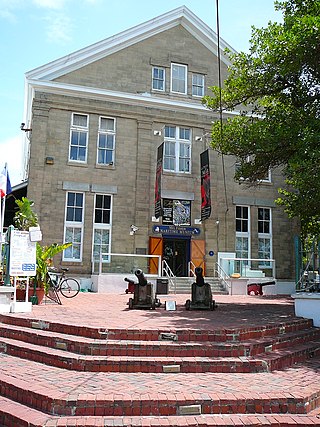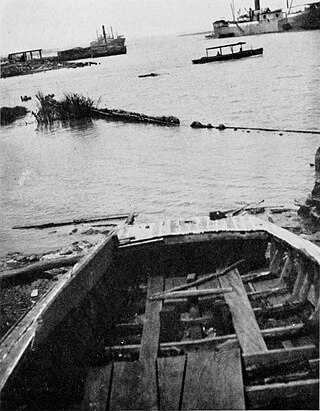Mel Fisher was an American treasure hunter best known for finding the 1622 wreck of the Nuestra Señora de Atocha in Florida waters.

Whydah Gally was a fully rigged galley ship that was originally built as a passenger, cargo, and slave ship. On the return leg of her maiden voyage of the triangle trade, Whydah Gally was captured by the pirate Captain Samuel "Black Sam" Bellamy, beginning a new role in the Golden Age of Piracy.
The Middle Passage was the stage of the Atlantic slave trade in which millions of enslaved Africans were transported to the Americas as part of the triangular slave trade. Ships departed Europe for African markets with manufactured goods, which were then traded for slaves with rulers of African states and other African slave traders. Slave ships transported the slaves across the Atlantic. The proceeds from selling slaves was then used to buy products such as furs and hides, tobacco, sugar, rum, and raw materials, which would be transported back to northern Europe to complete the triangle.

Nuestra Señora de Atocha was a Spanish treasure galleon and the most widely known vessel of a fleet of ships that sank in a hurricane off the Florida Keys in 1622. At the time of her sinking, Nuestra Señora de Atocha was heavily laden with copper, silver, gold, tobacco, gems, and indigo from Spanish ports at Cartagena and Porto Bello in New Granada and Havana, bound for Spain. The Nuestra Señora de Atocha was named for a holy shrine in Madrid, Spain. It was a heavily armed Spanish galleon that served as the almirante for the Spanish fleet. It would trail behind the other ships in the flota to prevent an attack from the rear.

Dry Tortugas National Park is an American national park located about 68 miles (109 km) west of Key West in the Gulf of Mexico, in the United States. The park preserves Fort Jefferson and the several Dry Tortugas islands, the westernmost and most isolated of the Florida Keys. The archipelago's coral reefs are the least disturbed of the Florida Keys reefs.

Slave ships were large cargo ships specially built or converted from the 17th to the 19th century for transporting slaves. Such ships were also known as "Guineamen" because the trade involved human trafficking to and from the Guinea coast in West Africa.

Bilboes are iron restraints normally placed on a person's ankles. They have commonly been used as leg shackles to restrain prisoners for different purposes until the modern ages. Bilboes were also used on slave ships, such as the Henrietta Marie. According to legend, the device was invented in Bilbao and was imported into England by the ships of the Spanish Armada for use on prospective English prisoners. However, the Oxford English Dictionary notes that the term was used in English well before then.

The archaeology of shipwrecks is the field of archaeology specialized most commonly in the study and exploration of shipwrecks. Its techniques combine those of archaeology with those of diving to become Underwater archaeology. However, shipwrecks are discovered on what have become terrestrial sites.

The Mel Fisher Maritime Museum is located at 200 Greene Street, Key West, Florida. The museum contains an extensive collection of artifacts from 17th century shipwrecks, such as the Henrietta Marie, Nuestra Señora de Atocha and Santa Margarita. Also included are the shipwrecks and artifacts of The Santa Clara, a Conquistador-era galleon (1564), The Guerrero & Nimble. A rotating gallery exists on the second floor of the museum and is currently displaying an exhibit or artifacts belonging to Cuban Rafters, Balseros, who arrive to Key West in hand-crafted vessels. Terrestrial archaeological sites include The African Cemetery of Key West, located on Higgs Beach. The museum is named for founder Mel Fisher and was created as a 501(c)3 non-profit charity organization, thus Fisher's fortune is not financially linked to the museum. It is a museum, a lab, and a nationally recognized research facility.
The Hannibal was a slave ship, hired by the Royal African Company of London. The ship participated in two slave trading voyages, in the Triangular trade. The wooden sailing ship was 450 tons and mounted with thirty-six guns. The ship is most remembered for her disastrous voyage of 1693–95. Captain Thomas Phillips commanded the Hannibal. He was a Welsh sea captain from Brecon, Wales who was employed by the Sir Jeffrey Jeffreys, and others. who owned the Hannibal and were governors and Assistants in the Royal African Company.

The schooner Clotilda was the last known U.S. slave ship to bring captives from Africa to the United States, arriving at Mobile Bay, in autumn 1859 or on July 9, 1860, with 110 African men, women, and children. The ship was a two-masted schooner, 86 feet (26 m) long with a beam of 23 ft (7.0 m).
The Molasses Reef Shipwreck is the site of a ship which wrecked in the Turks and Caicos Islands early in the 16th century. It is the oldest wreck of a European ship in the Americas to have been scientifically excavated.
Guerrero was a Spanish slave ship that wrecked in 1827 on a reef near the Florida Keys with 561 Africans aboard. Forty-one of the Africans drowned in the wreck. Guerrero had been engaged in a battle with a British anti-slavery patrol ship, HMS Nimble, stationed on the northern approaches to Cuba. Nimble also ran onto the reef, but was refloated and returned to service. The two ships were attended by wreckers, who rescued the Spanish crew and surviving Africans from their ship and helped refloat Nimble. Spanish crew members hijacked two of the wrecking vessels and took almost 400 Africans to Cuba, where they were sold as slaves. Most of the remaining Africans were eventually returned to Africa.
Antelope was a slave ship that the United States captured in 1820 with more than 280 captive Africans aboard. It had been legally engaged in the African slave trade under the flag of Spain when it was taken over by a privateer at Cabinda. The legal case on the fate of the captured Africans, known as The Antelope, lasted for seven years, with some of the Africans being turned over as slaves to Spanish owners, while 120 were sent as free people to Liberia. Both the commandeering of the boat, as well as the ensuing trial, are the subject of the book Dark Places of the Earth, by Jonathan M. Bryant.

The São José Paquete Africa was a slave ship from the Kingdom of Portugal that sank in 1794 off the coast of Cape Town, South Africa. Close to shore, but in deep water, 212 of the 400 to 500 African slaves who were aboard died when the ship sank. In 2015, the Smithsonian's African American History Museum, South Africa's Iziko Museums, the Slave Wrecks Project, and other partners, confirmed discovery of the wreck near where it sank. The ship and its slaves were headed from Portuguese Mozambique to Colonial Brazil, during the height of the international African slave trade. Few other former slave ships have been found, but the São José is the first and only shipwreck discovered, as of June 3, 2015, of a working slave ship, which sank in transit with its human cargo aboard.
Goodrich was a brig launched in Bermuda in 1793. She made three voyages between 1795 and 1799as a slave ship in the triangular trade in enslaved people. She then became a general merchantman and was wrecked in 1808.
Adélaïde was a fourth-rate ship-of-the-line of the navy of Louis XIV, designed by François Couomb and launched in 1699 by the Toulon Dockyard. Between 1708 and 1714 she was chartered to several mercantile companies. She sank during a hurricane in October 1714 after having delivered slaves from West Africa to Saint-Domingue.
Liverpool, a port city in north-west England, was involved in the transatlantic slave trade. The trade developed in the eighteenth century, as Liverpool slave traders were able to supply fabric from Manchester to the Caribbean islands at very competitive prices.









